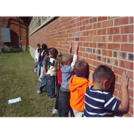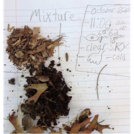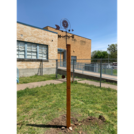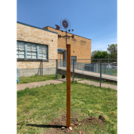
Students will observe and record the changes caused by weathering and erosion from moving water have on limestone.
- Subject:
- Physical Science
- Material Type:
- Lesson Plan
- Author:
- rgothaii@rgdeuceenterprises.com
- Date Added:
- 07/22/2021

Students will observe and record the changes caused by weathering and erosion from moving water have on limestone.

Students will explore the different areas of the garden to determine how warm or cool it feels.

Students learn about the definition of heat as a form of energy and how it exists in everyday life. They learn about the three types of heat transfer conduction, convection and radiation as well as the connection between heat and insulation. Their learning is aided by teacher-led class demonstrations on thermal energy and conduction. A PowerPoint® presentation and quiz are provided. This prepares students for the associated activity in which they experiment with and measure what they learned in the lesson by designing and testing insulated bottles.

Students are introduced to Newton's third law of motion: For every action, there is an equal and opposite reaction. They practice identifying action-reaction force pairs for a variety of real-world examples, and draw and explain simplified free-body diagram vectors (arrows) of force, velocity and acceleration for them. They also learn that engineers apply Newton's third law and an understanding of reaction forces when designing a wide range of creations, from rockets and aircraft to door knobs, rifles and medicine delivery systems. This lesson is the third in a series of three lessons intended to be taught prior to a culminating associated activity to complete the unit.

Students learn about the underlying factors that can contribute to Plinian eruptions (which eject large amounts of pumice, gas and volcanic ash, and can result in significant death and destruction in the surrounding environment), versus more gentle, effusive eruptions. Students explore two concepts related to the explosiveness of volcanic eruptions, viscosity and the rate of degassing, by modelling the concepts with the use of simple materials. They experiment with three fluids of varying viscosities, and explore the concept of degassing as it relates to eruptions through experimentation with carbonated beverage cans. Finally, students reflect on how the scientific concepts covered in the activity connect to useful engineering applications, such as community evacuation planning and implementation, and mapping of safe living zones near volcanoes. A PowerPoint® presentation and student worksheet are provided.

Students will recognize that mixtures are made when two or more materials from the garden are mixed together and the physical properties do not change.

During this activity, students learn how oil is formed and where in the Earth we find it. Students take a core sample to look for oil in a model of the Earth. They analyze their sample and make an informed decision as to whether or not they should "drill for oil" in a specific location.

Students learn about physical models of groundwater and how environmental engineers determine possible sites for drinking water wells. During the activity, students create their own groundwater well models using coffee cans and wire screening. They add red food coloring to their models to see how pollutants can migrate through the groundwater into a drinking water resource.

Students act as food science engineers as they explore and apply their understanding of cooling rate and specific heat capacity by completing two separate, but interconnected, tasks. In Part 1, student groups conduct an experiment to explore the cooling rate of a cup of hot chocolate. They collect and graph data to create a mathematical model that represents the cooling rate, and use an exponential decay regression to determine how long a person should wait to drink the cup of hot chocolate at an optimal temperature. In Part 2, students investigate the specific heat capacity of the hot chocolate. They determine how much energy is needed to heat the hot chocolate to an optimal temperature after it has cooled to room temperature. Two activity-guiding worksheets are included.

Students build their own simple conductivity tester and explore whether given solid materials and solutions of liquids are good conductors of electricity.

In this activity, students develop an understanding of how engineers use wind to generate electricity. They will build a model anemometer to better understand and measure wind speed.

STUDENT ACTIVITY - 1st -- TXThis is a distance-learning lesson students can complete at home.Students will gather evidence that the wind is moving by creating windsocks.This activity was created by Out Teach (out-teach.org), a nonprofit providing outdoor experiential learning to transform Science education for students in under-served communities. .

Students will observe that air is moving objects by creating wind socks.

The discipline of geography bridges the social sciences with the physical sciences and can provide a
framework for understanding our world. By studying geography, we can begin to understand the
relationships and common factors that tie our human community together. The world is undergoing
globalization on a massive scale as a result of the rapid transfer of information and technology and
the growth of modes of transportation and communication. The more we understand our world, the
better prepared we will be to address the issues that confront our future. There are many approaches
to studying world geography. This textbook takes a regional approach and focuses on themes that
illustrate the globalization process, which in turn assists us in better understanding our global
community and its current affairs.

roaches dot org links page

Το βιβλίο αυτό είναι μια εισαγωγή στις υπολογιστικές μεθόδους που χρησιμοποιούνται στη φυσική και άλλα επιστημονικά πεδία. Απευθύνεται σε κοινό που έχει ήδη εκτεθεί σε μαθήματα γενικής φυσικής που διδάσκονται στα δύο πρώτα έτη πανεπιστημιακών τμημάτων θετικών επιστημών και επιστημών του μηχανικού. Δεν υποθέτει κανένα υπόβαθρο αριθμητικής ανάλυσης, προγραμματισμού ή χρήσης υπολογιστή και παρουσιάζει ό,τι είναι απαραίτητο για την επίλυση των προβλημάτων που παρουσιάζονται στο βιβλίο. Μπορεί να χρησιμοποιηθεί ως κύριο σύγγραμμα σε εισαγωγικά μαθήματα υπολογιστικής φυσικής και επιστημονικού προγραμματισμού.